Garden Drainage
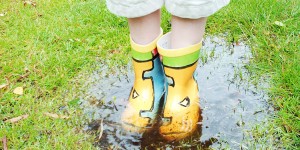 Garden drainage is an important aspect of gardening and agricultural practices all over the world.
Garden drainage is an important aspect of gardening and agricultural practices all over the world.
Its influence on plant growth, soil conditions and garden management cannot be understated.
The subject is complex, involving a number of scientific disciplines, including the hydrological cycle, geology, meteorology, and soil science.
Therefore the exact nature and effects of a given garden drainage problem depend on a whole variety of circumstances and conditions. While many of the answers to a problem may be available, they are rarely singular and instead are best dealt with from several approaches.
Proper watering is vital to maintaining a healthy garden, but even the most meticulous watering schedule will be wasted if soil does not properly drain. Without proper garden drainage, weeks and months of hard work in the garden will be lost as plants either wither or suffer from root rot.
The soil could be unable to retain water due to high sand content and poor quality. Or the soil could be retaining too much water because of high clay content and too much compaction. Either way, the plants will not thrive if garden drainage conditions are not optimal.
This guide is intended for the average backyard gardener, but the information it provides is equally applicable to large-scale operations or gardening consultants. In it I will begin by presenting an overview of the basics of garden drainage, beginning with an explanation of the hydrologic cycle.
Hydrologic cycle is the circulation of water through the environment, and it is the foundation of everything else I will discuss. Next I will talk about the relationships between soil, water, and plant growth. Understanding these relationships is valuable when approaching the subject of garden drainage.
Then I will examine the processes that affect garden drainage, including rainfall, groundwater, and surface water. In the final sections I will discuss strategies and design for various garden drainage plans. I will pay attention to inexpensive strategies, as many gardeners are often on a budget, and explain the importance of thorough preparation in design and application of garden drainage systems.
While garden drainage is as crucial to the health of the garden as it is complex in its subject matter, I am confident this guide will prove easy to understand and thorough in its treatment. The strategies contained within should be enough to assist in solving all but the most dire garden drainage problems. Let’s get started.
1. The Hydrologic Cycle
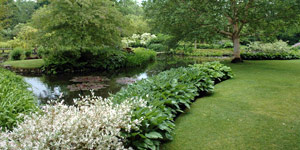 The circulation of water through the atmosphere and around the surface of the earth affects the soil in a number of ways. In some circumstances conditions will lead to accumulations of excess water, resulting in garden drainage problems. In this section I explain the relationship of this cycle to garden drainage problems.
The circulation of water through the atmosphere and around the surface of the earth affects the soil in a number of ways. In some circumstances conditions will lead to accumulations of excess water, resulting in garden drainage problems. In this section I explain the relationship of this cycle to garden drainage problems.
1a. Precipitation
With very few exceptions, all water found in soil is derived, directly or indirectly, from the atmosphere. The atmosphere carries water vapor because of the effect of evaporation. Whenever air comes in contact with liquid water, some of the water molecules will pass into the atmosphere. Warm air can absorb more water than cold air.
Atmospheric circulation carries the air with its absorbed water molecules around the globe. This often causes the air to cool off. Any cooling of the air reduces its ability to carry water vapor, and past a certain point (the saturation point) any further cooling will force the water to condense. This is how clouds are formed.
When the water droplets form larger drops they fall to the ground as precipitation – a term that includes all rain, hail, sleet or snow that falls to the earth. For the purposes of this guide the term rainfall is used, but this includes other forms of precipitation as well. Rainfall is measured in units of length per unit of time, as in inches per year or millimeters per hour.
1b. Water Circulation
The fate of water that falls to the surface is varied. Some may return directly to the atmosphere, and the rest may remain on the surface or flow into the soil to become soil water and groundwater. Plant activity can return some of the soil water to the atmosphere. In some situations groundwater can be returned to the surface by various pathways through the soil or rocks.
Water on the surface will become runoff and join streams and rivers, through which it will eventually reach the ocean. This continuous circulation of water from ocean to atmosphere, to land surface, and back to the ocean is called the hydrologic cycle.
Understanding this cycle in some detail can identify the various causes of garden drainage problems.
In most conditions some of the rainfall will return to the atmosphere directly from the ground surface by evaporation. The rate of evaporation is controlled by the relative humidity in the air. Air that is completely saturated with water vapor has a relative humidity of 100%. If relative humidity is less than 100% the atmosphere can absorb more water and will dry the soil.
Growing plants remove much of the water from the soil. Some of the water absorbed by plants is turned into plant tissue. Most of it passes through the pores of plant leaves and enters the atmosphere as water vapor. This process is called transpiration. The rate of transpiration depends on a number of factors and is highest during the peak of the growing season. Combined evaporation and transpiration remove much of the water from the soil.
1c. Garden Drainage Problems
Garden drainage problems may arise as effects of the hydrologic cycle several ways, dependent on a number of factors. Garden drainage problems will have different characteristics depending on whether the ground is level or sloping, and whether soil is or is not highly permeable. Understanding a few very basic principles on this is key to determining more complex causes of garden drainage problems that may arise.
- On a level site where soil is well drained, the soil will dry out when evaporation and transpiration exceed rainfall. The soil will become wetter when rainfall exceeds evaporation and transpiration.
- On a level site where the soil is not well drained, water will collect on the surface when rainfall exceeds infiltration, the movement of water into the soil. Water will collect in the topsoil when infiltration exceeds percolation, the movement of water from the topsoil to the subsoil.
- On a sloping site where the soil is well drained, the soil will not necessarily become wetter when rainfall exceeds evaporation and transpiration, because water may move downhill.
- On a sloping site where the soil is not well drained, water will flow downhill along the surface when rainfall exceeds infiltration. Water will flow downhill through the topsoil when infiltration exceeds percolation.
These factors fall into two groups in terms of the nature of garden drainage problems. They are:
- The interaction of climate and soil characteristics: the first two bolded examples are concerned with the direct effects of rainfall and evaporation/transpiration. Rainfall varies widely, and evaporation is dependent on temperature and humidity. Generally speaking, the greater the rainfall, the lower the temperature, and the poorer the soil permeability, the greater the garden drainage problem.
- The effect of the ground’s grade: the second two bolded examples are concerned with the movement of water above or below the soil, and along the slope of the ground. In some instances these problems may be mitigated by changing the shape of the surface.
Garden drainage requires recognizing and mitigating the problems of excess soil water detailed above. They may occur singly or in combination. The basic requirements of garden drainage improvements may involve improving soil permeability and/or controlling the groundwater table in the soil profile. In the next section we will further understand the mechanisms and effects of garden drainage as we examine the relationship between soil, water and plant growth.
2. Soil, Water, and Plant Growth
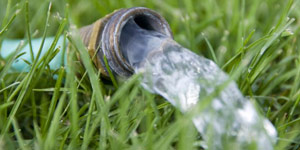 All plants need a supply of water to carry out their vital functions. For the plants in your garden, water is obtained from the soil and the amount of water available depends on the local climate and soil properties. With a wide range of such factors, many wild plants have become adapted to survive in one environment but do poorly in another environment.
All plants need a supply of water to carry out their vital functions. For the plants in your garden, water is obtained from the soil and the amount of water available depends on the local climate and soil properties. With a wide range of such factors, many wild plants have become adapted to survive in one environment but do poorly in another environment.
Crop plants and ornamentals are similarly restricted. Where crops are grown in dry soils it is usually necessary to irrigate. At the same time, however, soils that are too wet can inhibit plant growth.
In addition to the direct effect wet soil has on plants, it is also susceptible to damage by foot traffic which further reduces plant growth.
2a. Soil and Plant Roots
Most plants require topsoil that is easily broken up in order to permit growing root systems to move through the soil to obtain water and nutrients. These are extracted by means of the finer branches of roots, the root hairs. Root hairs are very delicate, with thin walls that come in close contact with soil particles.
Osmosis is the mechanism by which soil water passes through the root hairs into the plant’s root. To carry out osmosis, the root’s cells require a supply of oxygen. This is obtained directly from air occupying the spaces in the soil.
Hard, compacted soil physically prevents root growth because there is no air supply. Where soil is exceptionally loose and have a large proportion of air spaces the plants can suffer from lack of moisture in a dry season. Most vegetable plants are affected to some extent if the soil in the rooting zone becomes saturated for a given amount of time.
Plants that are adapted to wetter soils survive saturation because air passes to the root cells from the atmosphere through air passages within the plant, or because they have an extensive shallow root system that grows above the zone of saturation.
Water that is absorbed into the plant has four functions. Transpiration causes absorbed water to pass from the roots to all parts of the plant, and ultimately out through the stomata on the leaf surface, where it is lost as water vapor. This loss of water causes a suction force in the plant that ensures a constant supply of water which reduces the risk of wilting.
Water is needed to provide turgidity to the plant. Most of the plant’s aboveground structures do not have any supporting tissue and the plant’s only mechanism for withstanding the stresses of wind and rain. Water serves the function of transport to move nutrients from one part of the plant to another. And water is a function of photosynthesis, the process by which green plants convert the sun’s energy into a form that can be used by its tissues.
2b. Soil: Water and Air
The amount of water in soil is called the soil water content. It varies with the seasons as the balance of inputs and outputs change. It also varies from soil to soil depending on how loose or compacted the soil is and how loamy or sandy the soil is. Any soil will become saturated to the surface immediately after a period of heavy rainfall.
When rainfall stops, provided the soil can drain freely, water will drain from the larger soil spaces in a few days or less. When evaporation and transpiration become the dominant factors, the soil will dry out. As the water loss continues the soil will reach a point where plants can no longer extract sufficient water to maintain turgidity and they will wilt.
Every living plant cell needs a continuous supply of oxygen for respiration. The resulting carbon dioxide produced by photosynthesis must also be allowed to escape. This exchange of gases presents little difficulty in the plant’s leaves, where a network of air spaces connects the plant’s inner tissues to the atmosphere.
In some species, like rice, this network extends down into the root system. But for most plants the network does not reach the roots, and so air spaces are necessary to allow roots to reach oxygen.
Spaces in soil can be classified according to their size. The effect they have on the soil’s properties and behavior is determined by the distribution of various sizes through the soil. This distribution, along with the size of mineral particles in the soil, will determine what kind of soil you are working with.
Soil water is held in these spaces by a force called soil water tension, which will be zero in waterlogged soil, but will increase as soil dries out.
2c. Poor Garden Drainage Effects
Depending on the makeup of the soil, local climate, and the garden’s position in the landscape, soil can exhibit any condition from mostly dry to mostly wet. The condition that occurs most commonly during the crop-growing season is called the garden drainage status.
Because it is an important factor for vegetables and crops it is useful to classify soils according to their drainage characteristics. Various systems are used and are usually based on the different layers found in a freshly dug trench. A useful system describes five grades of garden drainage status. These are:
- Soils with excessive drainage: usually sandy or gravelly soil with large particles and large spaces.
- Soils with free drainage: soils which lose excess water rapidly but retain enough to sustain plant growth through most dry spells.
- Imperfect drainage: soils which lose excess water moderately, which may remain waterlogged for two or more weeks after rainfall.
- Poor drainage: soils which lose excess water slowly, or are situated where the groundwater table remains high, preventing successful plant growth.
- Very poor drainage: soils that are waterlogged to the surface most of the year.
The effects of poor garden drainage on gardens and the general symptoms of poor garden drainage vary from site to site depending on the severity of the problem. It is the task of the gardener to recognize the symptoms and evaluate the loss of plants compared to the cost of improvement.
Sites may be extremely wet: standing water or wetlands. They may be moderately wet: poorly drained areas. They may be better drained. Certain plants thrive in wetlands, and the ornamental gardener may wish to adapt the garden to the site rather than adapt the site to the garden.
Vegetable gardens and many popular ornamentals require varying levels of garden drainage, and again, the gardener should weigh the pros and cons of adapting the garden to the site.
Many vegetables can suffer from poor garden drainage in various ways. Soils with drainage problems take longer to dry out in the spring, so planting time is delayed or the seed can fail to germinate and die soon after planting. Those plants that do survive will always be stunted.
Roots that encounter saturated topsoil will stop growing downwards and instead grow sideways, resulting in poorly rooted plants. Bare patches will persist in the garden where surface soil is saturated. These bare patches soon will become havens for weeds. Finally, saturated soils will harbor diseases and cause root rot.
Soils that contain a fair amount of clay are malleable when wet. In this condition the soil is easily compacted when subjected to foot traffic while the gardener is cultivating or harvesting vegetables. In the worst conditions the surface will become muddy and churned up.
This will make it virtually unworkable. As compacted soils dry, the will become extremely hard and impermeable to roots and spades alike. Garden drainage will be hindered, creating a self-perpetuating cycle of deterioration.
3. Processes Affecting Garden Drainage
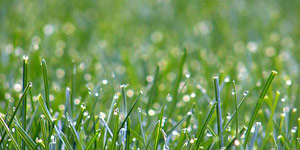 In this section I will examine four processes that act in concert to affect garden drainage in soils. Understanding how these processes work together to affect garden drainage is vital to finding the source of your garden drainage problems and planning and implementing strategies to correct them.
In this section I will examine four processes that act in concert to affect garden drainage in soils. Understanding how these processes work together to affect garden drainage is vital to finding the source of your garden drainage problems and planning and implementing strategies to correct them.
3a. Organic Matter in Soil
All soils contain some form of organic matter as a result of biological activity. The amount found in your garden depends on a number of factors. Essentially it is controlled by the difference between the production of new plant growth and the rate of decay of detritus (annual die-back and fallen leaves).
If the growth rate exceeds the decay rate, then the organic content in the soil increases. Conversely, any factor that accelerates decomposition and reduces the supply of plant materials will lower the organic matter content. Most soils in temperate latitudes (Europe and North America) contain between five and ten percent organic matter in the topsoil. The amount present can be increased or maintained by adding compost or mulching with dead plant matter.
The organic content of soil is reduced by continually growing arable plants without treating the soil with composting or mulching.
Soil structure is the tendency of individual mineral particles and other soil components to bind together. Soil may be classified as clays, sandy soils, or silt. The ideal soil is a loam, or a mixture of approximately 40 percent sand, 40 percent silt, and 20 percent clay, as well as a healthy amount of decomposed organic matter.
Soil structure is influenced heavily by the amount of organic matter present. Soils with an extremely high degree of organic matter are known as peat, and do not drain very freely. In the typical backyard garden, the soil structure and organic content can be mitigated by tilling organic matter and loamy soils or sand – depending on the existing structure of the topsoil – into the garden.
3b. Rainfall
The amount and frequency of rainfall vary over the landscape for a number of reasons. Such variations are important to the gardener and paying attention to meteorological predictions is essential for garden planning. The general climatic characteristics of any area are determined by is latitude and location near a large body of water.
The day-to-day variations in weather result from the properties of air masses, or fronts, passing through the area. As maritime tropical air moves over an area it will cool the area and reduce its ability to retain water. This will cause air to rise and eventually produce precipitation.
The soil makeup will be largely affected by the rainfall in your area. The amount of rainfall will also determine the importance of drainage in your garden. If you live in an arid climate, such as the American Southwest, draining water will be of less importance than retaining water.
If you live in a temperate climate, the garden drainage problems will be more due to soil structure and land grade but not necessarily rainfall. If you live in a rainy environment, such as the Pacific Northwest, garden drainage will be of major concern and related to rainfall.
Soil in these different regions all have garden drainage problems only in the critical season when any excess of soil water can damage the gardener’s plants – especially in the vegetable garden. In areas where there is rainfall year round, the critical season is the whole year.
In the American Midwest, the critical season is spring through autumn. In most other regions the critical season is the six months during which plant growth in gardens is peaking.
3c. Surface Water
In humid regions, excess rainfall flows across the land surface, and where there is enough of it, permanent channels are formed. These range from the tiniest of streams to the mightiest rivers. By variously eroding, transporting and depositing water and sediment they adjust to prevailing conditions. Man-made channels constructed to add garden drainage become extensions of the natural system. Both types of channels act as outlets for excess soil water.
The amount of surface water lost from an area – whether a modest garden or a major industrial farm – is called runoff. A natural water-collecting area is called a catchment, whether it is a natural basin or a larger pond. Assessing run-off is an important part of garden drainage work. If you are working in a backyard garden, notice the amount of surface water that is pooling in the garden.
Also take note of whether and where water is running out of the garden. If you have a natural catchment in your yard, direct runoff to it with channels along the garden beds and use this as a reserve water source. For the average household garden, surface water will be of much more concern than groundwater, which affects much larger operations.
As previously discussed, rainfall can either seep into the soil and become groundwater or flow over the surface as run-off. Surface channels are affected directly by runoff. In small catchments the channels may dry up when the soils in catchments have a water deficit.
In larger catchments there is enough groundwater to ensure continuous flow; this is called base flow. This will only be relevant to larger plots of land and is not a consideration for backyard gardeners. Hobby farmers and garden drainage consultants will do well to consider the base flow of a garden drainage system.
3d. Groundwater
Groundwater is affected by gravity just like surface water, but groundwater movements are influenced by the structure of the soil as well. Groundwater occupies all empty spaces in the soil to a depth of about 1000 yards (900m).
Groundwater can move in any direction in response to variations in pressure caused by changes in the amount of water at the surface. Groundwater is affected by much larger factors than surface water, as it includes much of the local water table. It is a subject of concern only in large agricultural operations, and the average gardener need not worry about its effects.
Where groundwater is a concern, garden drainage design must try to match the nature of groundwater movements. A high groundwater table in a surface aquifer will require a system of drainage channels set close enough together to control saturation across the entire site. It may require the establishment of small canals or irrigation ditches at the perimeter of the site. Garden drainage to control groundwater movements typically requires specialized techniques.
4. Garden Drainage Strategies
4a. Low-Cost Garden Drainage
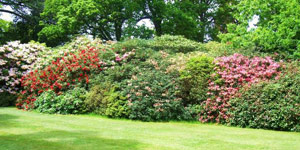 Many sites that have garden drainage problems are not worth the cost of comprehensive underground drainage because the installation cost is prohibitive. Many areas are limited by difficult weather conditions which sufficiently inhibit plant growth to preclude all but the hardiest species. In sites like this, even where good garden drainage is technically attainable, it should not be attempted for budget reasons.
Many sites that have garden drainage problems are not worth the cost of comprehensive underground drainage because the installation cost is prohibitive. Many areas are limited by difficult weather conditions which sufficiently inhibit plant growth to preclude all but the hardiest species. In sites like this, even where good garden drainage is technically attainable, it should not be attempted for budget reasons.
Similarly, in areas where more productive gardening activities could be expected there are sites that should not be comprehensively drained because of high installation costs. There are also sites that cannot be satisfactorily drained no matter how much is spent on them. However nearly all sites justify some limited improvement so long as cost is carefully evaluated.
The most basic strategy for low-cost garden drainage on a sloped piece of land is cutting a system of small surface channels to drain the site, called hill drains. The channels can be cut as a continuous furrow in the topsoil about 1.5 feet (40cm) deep. If the garden is sufficiently small, this may be done by hand, using a spade, although it will be hard work.
Alternately a small mechanical digger can be utilized; these are often available for rent at garden supply centers. The channels should have stable walls. The removed soil, or furrow, should be set on the down-slope side of the channel at least two feet (60 cm) from the edge.
Hill drains deteriorate year by year due to erosion, bank collapse or flooding, and the channels should be re-dug every ten years or so.
Gardens that lie at the bottom of hill slopes can receive considerable inflows of surface water after heavy rainstorms. Surface inflows can be cured relatively cheaply by digging interceptor ditches along the margin closest to the bottom of the hill of the area to be protected.
4b. Soil Treatment
Many soil structures are either totally impermeable or so slowly permeable that there is no significant flow of water into the ground. In such cases it is necessary to improve subsoil permeability by tilling the soil and refilling the subsoil with permeable material.
This is a major undertaking which will require moving a great deal of soil, and it is not recommended without the use of machinery such as a backhoe.
In such a case the topsoil is stripped off and retained and the subsoil is permeated with drains. The drains are dug with the use of mole ploughs, which creates an unlined channel deep in the subsoil.
An alternative for the small backyard gardener who is sub-soiling is the process of breaking up the top layers of subsoil by using a mechanical digger. For the backyard gardener, the soil can be disrupted using a roto-tiller. After this is done, raised beds should be constructed above the aerated soil with a mixture of compost, loam, and fertilizer.
The raised beds may be contained in constructed planters or made by simply heaping soil onto the planting site. They should be about eighteen inches (40 cm) high. This will ensure that vegetables in the garden will have ample room for roots and drainage should be controlled to desirable depths. Check garden drainage regularly and be careful not to compact the garden beds. For smaller gardens this should work for all but the most serious garden drainage problems.
4c. Pumped Garden Drainage
Many sites do not have an outlet for garden drainage by gravity flow. In the majority of these sites the only feasible method of improvement is to pump the excess water into an outflow channel that is elevated above the level of the field drains.
Pumped garden drainage can be technically feasible for a wide range of sites from large regional projects, as in the polders of the Netherlands, to very small setups serving only one drain. Small projects, involving only a small property, can be within the scope of an individual.
I will cover the basic considerations of pumped garden drainage in this section, and strongly recommend consulting a professional land improvement specialist before undertaking such a project.
Physical limitations are the major factor limiting pumped garden drainage. These include the volume of water that must be pumped out of an area; the height the pumped water will have to be elevated; the suitability of the site for installing pumping equipment; and the effect of drainage on the local environment.
The decision to proceed with pumping depends on balancing the pumping costs against the estimated returns. Obviously if a household property lies in an area that is prone to flooding, the costs may not be measurable against the safety of the household. For agricultural operations, however, improvements made may well increase capital returns.
Once the decision has been made to install pump garden drainage the next step is to improve the site to reduce as much as possible the amount of water that has to be pumped. This requires making use of all available gravity outflows and isolating the drained area from all types of inflows as possible. A proper reservoir site must be found and its capacity assessed.
Overall pumped garden drainage is a major undertaking, requiring investments of capital and time. It should be used only when other methods are not working and when the area in question absolutely must be drained.
5. Garden Drainage Design
5a. Garden Drainage Layout
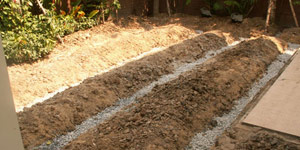 Choice of layout depends on the identified garden drainage problem, the side gradient and the various soil structures present. Drain intervals in regular systems are a part of the layout, although choice of spacing does not alter the basic pattern. Drain depth may influence spacing but does not alter layout.
Choice of layout depends on the identified garden drainage problem, the side gradient and the various soil structures present. Drain intervals in regular systems are a part of the layout, although choice of spacing does not alter the basic pattern. Drain depth may influence spacing but does not alter layout.
A system composed of a series of individual drains, each with direct outlet to an open channel, is called a singular layout. A system of laterals and lead channels all discharging at a single outlet is called a composite layout. Larger areas of land may require additional outlet channels. Open channel garden drainage can be arranged in a variety of layouts.
Where land is drained by open channels (ditches) only, some ditches will be associated with land grading, and in these cases spacing is influenced by a complex set of engineering problems. However for the majority of cases various criteria are needed in placing ditches.
The first is the function of the ditch: carrier ditches conduct water towards the main outlet and should follow the line of any natural hollows or valleys, towards the lowest part of the site.
Collector ditches should be set as short as straight as possible along the lower end of the area to be drained.
Interceptor ditches should be sited along the upper end of the site to be protected, as mentioned earlier.
In most cases a single ditch is sufficient to divert surface water from the site.
5b. Spacing and Depth
The spacing between drain lines in a regular layout is perhaps one of the most important topics in garden drainage design. Generally speaking, drains that are too far apart will fail to drain the soil adequately while those that are placed too closely, although successful, are unnecessarily expensive. Even so, it would be a mistake to overstate the importance of this facet of garden drainage design.
It is more important to correctly diagnose the garden drainage problem or problems and apply the best garden drainage solution. When this is done correctly the choice of drain spacing does not need to be a precise calculation. All that is necessary is that spacing is of the correct order and at standard intervals.
The depth chosen for underground garden drainage such as mole ploughs or mechanical tilling is limited by the site’s topography and the minimum amount of soil cover necessary to prevent damage by foot traffic.
Where there is an appreciable range of depth available, the depth chosen is determined by the garden drainage problem. Since depth and spacing are related factors it is convenient to discuss them together when you are designing the layout.
5c. Types of Garden Drainage Problems
For most practical purposes garden drainage systems are required to solve one or more of a few basic garden drainage problems. These are briefly discussed in turn in this section. The approach required will be determined by the problem or problems you encounter.
Overland surface flow is most conveniently controlled by ditches. Where underground garden drainage is used it must be connected directly to ground surface by means of permeable fills such as gravel or pebbles. Piped drains can be used to control small surface flows such as springs that cannot be drained directly.
These drains must be placed along the upper end of the land to be protected and at minimal possible depth.
Ground flow and spring seepage is controlled by intercepting before it can saturate the plant rooting zone in the soil structure. In almost every case this requires the careful placement of interceptor ditches. The interceptor should have an impermeable barrier running along its down-slope side to assist in the interception of ground flow.
Miscellaneous problems include working on a river flood plain, garden drainage work in organic soils, and garden drainage work in unstable soils. Flood plains are complex structures that require careful consideration before any garden drainage projects are attempted; there is often a high water table as well as other complications.
Wholly organic gardens‘ soil structures such as peat present special problems, and therefore require a thorough cost/benefit assessment. Unstable soils present the problem of washing particles into pipes and blocking them. This requires the use of fine gravel and filtering devices. For any of these instances it is imperative to consult a garden drainage specialist.
6. Final Word
 Garden drainage problems are best solved if the work is performed in a logical sequence. With so many factors to consider it is easy to miss a step and make a design decision before all the relevant information is available. Every facet of garden drainage design must be considered for every site and it is necessary to develop an organized, systematic approach. A check list can prove very helpful.
Garden drainage problems are best solved if the work is performed in a logical sequence. With so many factors to consider it is easy to miss a step and make a design decision before all the relevant information is available. Every facet of garden drainage design must be considered for every site and it is necessary to develop an organized, systematic approach. A check list can prove very helpful.
For any site, I recommend beginning with a preliminary survey to examine the potential benefits to be obtained from garden drainage as well as evidence of garden drainage limitations. Then perform a detailed survey.
Sketch the site and surrounding area showing boundaries, power lines, existing ditches and fences. Examine nearby ditches and underground garden drainage systems. Identify soil structure.
Next, determine what maintenance work will improve garden drainage simply by improving the existing system or improving soil structure.
Then, if it is apparent that new garden drainage works are needed, proceed with garden drainage design. At this stage it is useful to consult with a professional specialist.
Finally, seek estimates from contractors and begin work. Observe the site during the next wet season and note improvements or faults in your garden drainage system.

